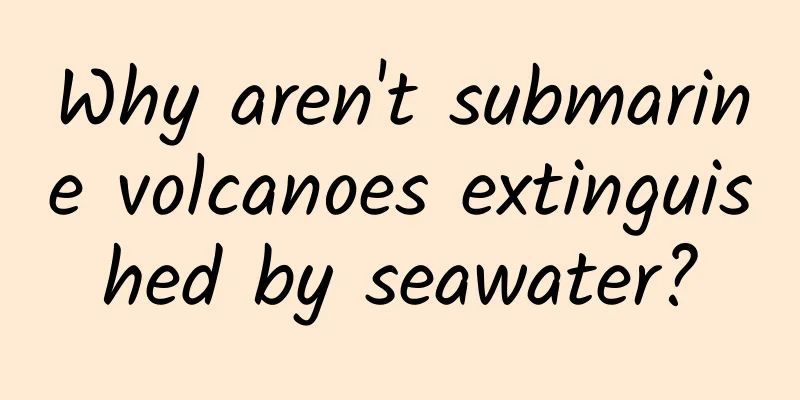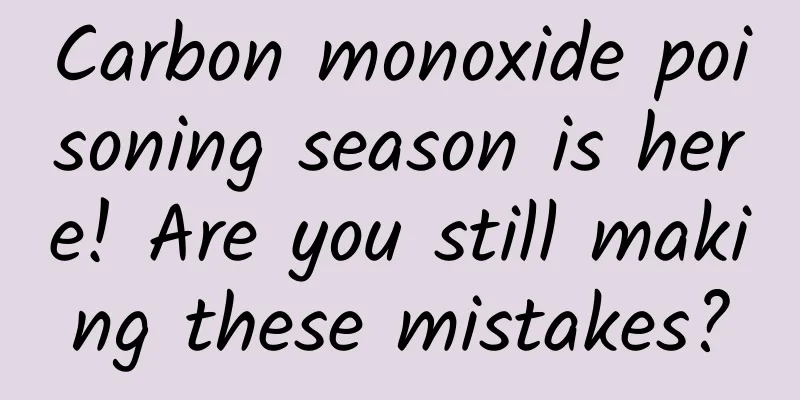Why aren't submarine volcanoes extinguished by seawater?

|
We often see such scenes in disaster-themed movies and TV shows: underwater volcanoes erupt violently, stirring up terrible whirlpools and huge waves... Faced with this picture, many people have had such a question in their minds: Why aren't underwater volcanoes extinguished by sea water? Part 1 Volcano ≠ mountain that spews fire Before understanding this problem, we need to correct some people’s wrong impression: volcano ≠ a mountain that spews fire. When many people think of a volcano, their first reaction may be a towering conical mountain spewing thick columns of smoke - it looks like a mountain spewing fire. After a volcanic eruption, a large amount of white volcanic ash falls over a large area, which is also very similar to the common ash we see, both fine particles of dust, and both grayish white. So many people subconsciously think that volcanoes = mountains spewing fire. The fiery red color and billowing black smoke make the volcano look like it is actually on fire. (Image source: Wikipedia) But if we zoom in and observe the volcano up close, we will find that this is not the case at all. Because the lava erupted by the volcano is actually a high-temperature fluid, which is essentially no different from water, but is a completely different substance from fire. Many close-up photos of lava can clearly show that they are often no different from liquid. When we were young and studied physics, we knew that matter has three phase changes: gas, liquid, and solid. The melting point and boiling point are related to the phase change. Take water as an example. The melting point of water is 0℃ and the boiling point is 100℃. When the temperature is below 0℃, we see solid water - ice; when the temperature is between 0℃ and 100℃, we see liquid water; and when the temperature is above 100℃, we see gaseous water - water vapor. This glass of water contains three phases of water: gas, liquid, and solid. (Image source: Wikipedia) Basically, all substances are like this, with melting points and boiling points, and they change phases with temperature. Magma is molten rock - because the composition of rocks is very complex, the melting points and boiling points of different components inside are inconsistent, so most magma is actually a mixture of solid, liquid and gas. In contrast, flames are the process of combustibles releasing light and heat as well as various chemical products during combustion. In flames, the main material components are carbon dioxide, water vapor, oxygen, nitrogen and other gases. Magma is a hot solid-liquid-gas mixture (Image source: Wikipedia) Flame is hot gas (Image source: Wikipedia) After understanding that volcanoes spew out magma, which is a high-temperature molten body rather than fire, we should be able to understand that when an underwater volcano erupts, the magma entering the sea water is actually like pouring hot water into a cold water sink, rather than a fire erupting from the bottom of the sea - the cold water will cool the hot water, but it cannot make the hot water disappear like extinguishing a flame, unless we manually turn off the hot water tap. Part 2 Where do submarine volcanoes come from? So the question here becomes, since the submarine volcano is like a faucet that continuously spews out hot water, and the seawater will cool the magma and turn it into rock, then the huge amount of seawater will undoubtedly solidify the spewed-out magma, thereby blocking the crater and preventing the submarine volcano from erupting again, right? The answer is no, because volcanoes are actually the product of planetary-level heat and material circulation, and volcanic activity will not stop until the Earth dies. The entire earth actually operates according to basic physical and chemical laws, which are not profound. For example, the formation and activity of volcanoes can be explained by the second law of thermodynamics - it sounds very professional, but its Clausius expression is very close to our lives: heat always flows spontaneously from high-temperature heat sources to low-temperature heat sources, not vice versa. If we trace back the 4.6 billion years of evolution of the Earth, we will discover the effect of this law: about 4.6 billion years ago, the Earth was gradually born from the collision of countless planets. The energy of the collision was converted into heat. Therefore, the Earth at that time was a huge magma ball (the entire or most of the surface was magma) with a surface temperature of thousands of degrees Celsius. Under the impact of countless asteroids, the earth is a red magma ball, and the ring in the picture is caused by the impact. (Photo credit: flickr/Kevin Gill) Then, because magma is fluid, heavy materials sink and light materials float (see, here is another physical rule). When heavy materials sink, their gravitational potential energy is converted into heat energy; at the same time, the radioactive elements originally scattered in the planetesimals are gathered together, decaying continuously and releasing energy. This energy keeps the magma inside the earth heated. But at the same time, because the background temperature of the universe is very low, averaging -270°C, the earth continuously transfers heat outward in the form of thermal radiation (there are three ways of heat transfer: heat conduction, thermal convection, and thermal radiation, but the universe is a vacuum and there is no medium, so the earth can only transfer heat outward in the form of thermal radiation). Since heat has been transferred, the earth must cool down - the surface will cool down first, so the magma here will cool down first to form rock, which is the original crust. As the Earth gradually cooled, magma formed the first rocks (black in the picture) After further evolution, the original crust was finally formed. (Image source: wikipedia/Jack Madden) By now, the Earth has evolved into a three-layer structure of crust, mantle, and core, and the temperature is getting higher from the crust to the core. At the same time, because heavy materials continue to sink, their density is also getting higher and higher - the average density of the crust is 2.8g/cm3, the average density of the mantle is 4.59 g/cm3, and the average density of the core is 11 g/cm3. So we can also think of the crust as "floating" above the mantle - just like a board floating on water. The three layers of the earth (Image source: 123rf) At this point, we can imagine the Earth as a hot pot - the core is the stove, and its energy comes from gravitational potential energy and radiant heat energy; the mantle is the hot pot soup base, which is constantly heated by the stove; and the crust is the cabbage stalk floating on the top. Under the heating of the core, the mantle constantly produces thermal convection - the hot mantle moves upward from the core, and the cold mantle material drills from under the crust to the lower layer. The thermal circulation pattern in the mantle is believed to be a full-mantle circulation, while others believe that it is a separate circulation in the upper and lower mantle. (Image source: Wikipedia) The crust is very thin compared to the mantle and core, with an average crust thickness of only 17 kilometers (33 kilometers for the continental crust and 10 kilometers for the oceanic crust). Even if the lithosphere composed of solid rocks at the top of the upper mantle is included, its thickness is only about 100 kilometers. In comparison, the mantle is as thick as 2,850 kilometers. Therefore, driven by the movement of the mantle, these thin solid rock layers will inevitably be torn apart and move with the mantle - just like the cabbage stalks on the hot pot will move endlessly due to the churning of the hot pot soup. The Earth's plates are constantly moving (Image source: Wikipedia) The torn parts of the crust become plates, and as the crust moves, the plates also move, some plates collide with each other, and some plates separate from each other. Common sense tells us that the boundaries of these separated plates are thin and fragile, and the mantle material underneath can easily break through the blockade of the rock layer and erupt to the surface - thus forming a long volcanic belt along the plate boundary. As the plates move further apart, the magma from the volcanic eruption at the plate boundary cools and forms a thin layer of strata, the oceanic crust. Since this layer is much thinner than the strata inside the plate, it is naturally a low-lying area, so water accumulates to form the ocean. In fact, this is how the ocean is formed, and the formation of the ocean is closely related to the movement of the plates. We can find oceans in various growth stages on the Earth today: rift valley-small ocean basin-mature ocean basin-ocean basin in the dying stage-ocean basin about to close-completely closed ocean basin. This is called the Wilson cycle in geology. Wilson Cycle (Image source: Wikipedia) Therefore, submarine volcanoes are actually the result of plate movement, and most of them are located at the boundary of plate separation. Since World War II, as humans have deepened their exploration of the ocean, we have discovered long submarine volcanic belts, most of which are located in the middle of the ocean and are called mid-ocean ridges. They are the longest mountain ranges in the world, with a total length of about 80,000 kilometers. Distribution map of mid-ocean ridges on Earth. Where there are mid-ocean ridges, there are submarine volcanoes. (Image source: Wikipedia) Of course, there are other submarine volcanoes. Their formation is related to the activity of mantle plumes. The mantle is not heated evenly everywhere. Some mantle materials are much hotter than other places. When they are hot, they will run upwards, so they will form mantle plumes that reach directly under the crust. The top of the mantle plume may also branch out into many small plumes. Their activities will also break through the constraints of the thin ocean crust and become continuously erupting submarine volcanoes. The formation of the Hawaiian Island Chain is related to this. In this theory, the position of the mantle plume remains unchanged, but due to the movement of the crust (dark blue arrows in the figure), the mantle plume forms a series of volcanoes on the crust. The numbers in the picture are the ages of the islands, in millions of years, for example, 4.89 means 4.89 million years. (Image source: getarchive.net) The Hawaiian Island chain from space (Image source: Wikipedia) But whether it is the edge of a plate or a mantle plume, the formation of volcanoes is the result of the heat cycle inside the earth. The thin layer of seawater on the surface alone cannot stop the activity inside the earth. So, there is no need to worry about the volcanoes on the seabed! Produced by: Science Popularization China Author: Earth's Gravity Producer: China Science Expo Editor: Sun Chenyu The article only represents the author's views and does not represent the position of China Science Expo This article was first published in China Science Expo (kepubolan) Please indicate the source of the public account when reprinting Please indicate the source of the reprint. Reprinting without authorization is prohibited. For reprint authorization, cooperation, and submission matters, please contact [email protected] |
>>: Some plants are valuable from head to toe, but taro is poisonous from head to toe...
Recommend
Thoughts and experience in Android development software architecture
1. Bud As a programmer with little programming ex...
Latest! The list of prohibited and restricted items for taking trains is here
The Year of the Rabbit Spring Festival holiday is...
Dou Shang 6.28 The latest and most comprehensive inappropriate methods on the Internet break and explain more than 20 methods
Doushang 6.28 The latest and most complete Douyin...
After interviewing dozens of designers, I summarized 12 common problems
Background Some time ago, the company was recruit...
Tonga volcano erupts, but the spewing of hot magma could cause global temperatures to drop?
Recently, the Hunga Tonga volcano (20.5°S, 175.4°...
The top ten PR cases that went viral in 2018, see who made the list!
It’s time for the year-end review again. Today, t...
How does Baidu bidding charge? Is there any contact information?
Baidu’s paid promotion is charged based on clicks...
Traffic volume not increasing? Can’t reduce costs? 3 excellent cases of increasing volume and reducing conversion costs!
What are the most concerns of many advertisers an...
Recommended places for drinking tea with studios in Nanjing, which you must not miss when traveling on business
Recommendations for places to taste tea in Jiangn...
“Sky-high electricity bills” has become a hot topic. What does it mean to use 9,330 kWh of electricity in a month?
Recently, the dispute between Wang Xiaofei and Da...
How much does it cost to join a courier mini program in Qinhuangdao?
For entrepreneurs, although mini program developm...
Weijing TV violent review: not as powerful as an idol
In the field of Internet TV, Whale can be said to...
The fitness equipment in a park in India was exercising on its own late at night. What was going on? Paranormal activity?
On the 13th, according to Indian media reports, a...
It turns out that there is such a big difference between snow accumulation and snowfall? | Expo Daily
It turns out there is such a big difference betwe...
Light, a strange world
Loading long image... Source: National Geographic...









